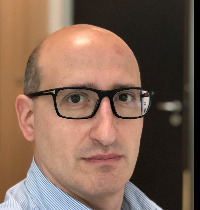
Luciano Conti
 Componente supplente
Componente supplente
Comitato per la protezione dei dati
 Professore associato
Professore associato
Dipartimento di Biologia Cellulare, Computazionale e Integrata - CIBIO
|
|
Formazione |
|
|
|
|
Carriera accademica ed attività didattica |
|
|
|
|
Interessi di ricerca |
|
His research has been directed toward the understanding of mechanisms regulating the self-‐renewal and differentiation of neural stem/progenitors cells of brain (Conti, Nat. Rev. Neurosci. 2010; Conti, TINS 2005). He has worked to the definition of the role of ShcA/C adaptor molecules in controlling the transition from proliferating neural precursors to mature neurons in the brain (Conti, PNAS 2007; Conti, Nature Neuroscience 2001; Ponti, Neurocience 2005 and 2010) and in brain tumors (Cattaneo, Anticancer Res. 1998; Magrassi, Oncogene 2005). A role for these molecules has been also enlightened in ES cells neuralization processes (Papadimou, MCN 2009). He has participated to studies that have defined a new role for BDNF and REST in a Huntington's Disease (Zuccato, Science 2001; Zuccato, Nature Genetics 2003). He has experience with immortalized neural precursors (Conti, JNR 1998; Ehrlich, Exp. Neurology 2002) neurosphere system and recently he has optimized the conditions for the generation of a novel population of neural stem cells with radial glia-‐like characteristics (Conti, PLoS Biol. 2005; Pollard & Conti, Progress in Neurob. 2007). This population has been named “NS” cells and displays improved homogeneity and enhanced long-‐term neuronal differentiation potential (Goffredo, CCD 2008; Spiliotopoulos, NBD 2009). He has shown that is possible to derive NS cells from mouse ES cells (Conti, PLoS Biol. 2005; Diaferia, Stem cells & Development 2011), human (Sun, MCN 2009) and mouse brain tissue (Pollard, Cer. Cortex 2006; Onorati, Mol. & Cell. Life Sci. 2010) and that this system can represent a exploitable tool for grafting (Brilli, Stem Cells and Development 2013), gene function (Cardano, JBC 2011; Paina, J. of Neurosci. 2011) and toxicological studies (Negri-‐Cesi, J. Steroid. Biochem. Mol. Biol. 2008). In the last years, his research interest has included:
|
|
|
|
Attività di ricerca |
|
Research activity in the lab is directed toward the understanding of mechanisms regulating self-renewal, fate decision and neuronal maturation of NSCs. In particular we are dissecting the roles of specific signal transduction molecules and transcription factors in the molecular circuitries that control the physiologic maintenance of normal NSCs and their specific alteration underlying tumorigenesis processes and neurodevelopmental diseases. The final aims are to exploit this knowledge in order to develop molecular and cellular tools for prospect cellular and pharmacological therapeutic interventions in the diseased brain. We pursue these goals by using both mammalian neural tissues and neuralizing processes applied to human and mouse pluripotent stem cell systems. We routinely combine a variety of techniques and tools to conduct our research including in vitro culture of mouse and human NSCs and pluripotent stem cells, molecular biology, biochemistry and cell-based assays. There are currently three major areas of interest in the lab:
|
|
|
|
Appartenenza a società e comitati scientifici |
|
Member of:
|
|
|
|
Premi e riconoscimenti |
|
|
|
|
Convegni e conferenze |
|
|
|
|
Altre attività |
|


